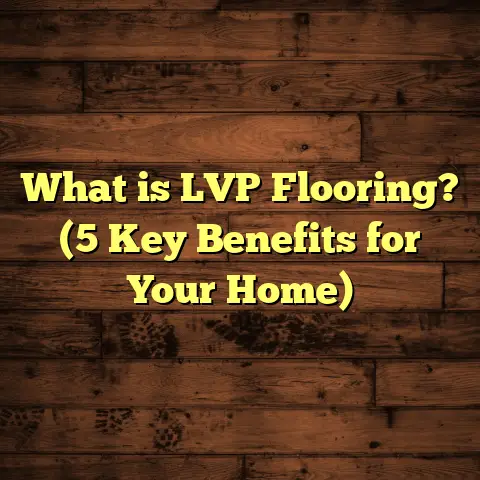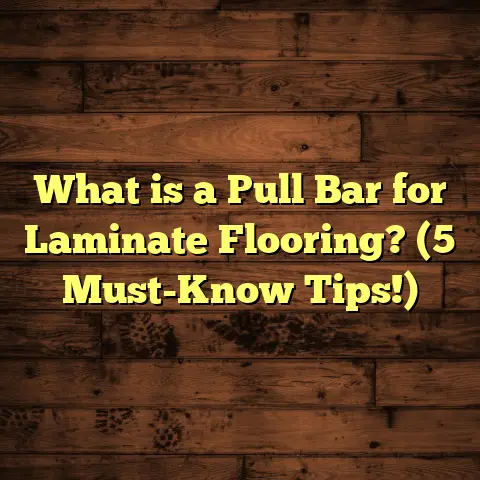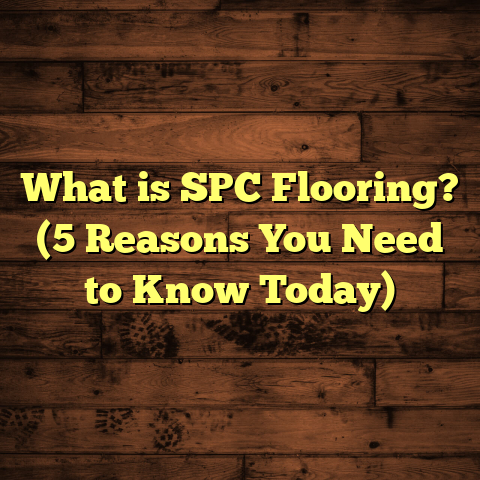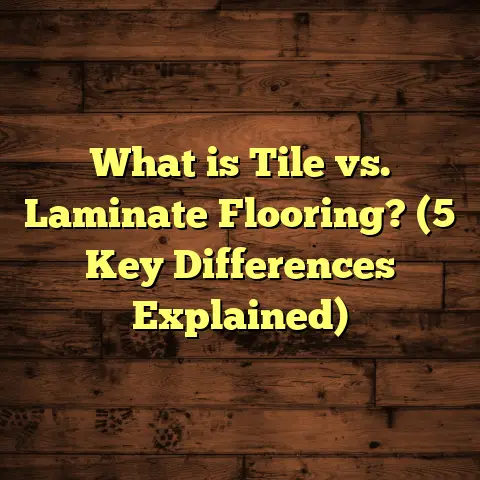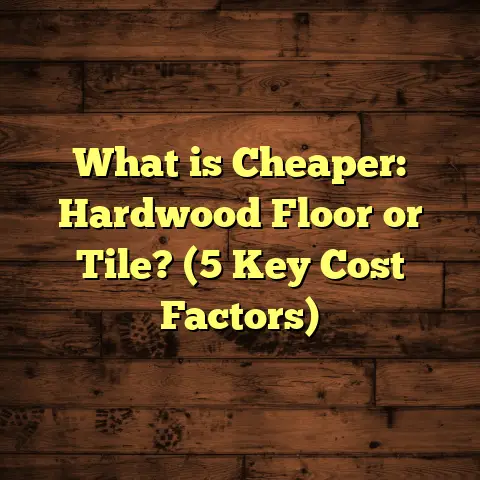What is SPC Vinyl Plank Flooring? (5 Reasons to Choose It!)
When I’m asked about quick and reliable flooring solutions, my mind immediately
goes to SPC vinyl plank flooring. Why? Because, honestly, I’ve seen how it can
transform a space fast without cutting corners on quality or style. If you’re looking
for a flooring option that’s durable, attractive, and easy to install, let me share
with you why SPC vinyl plank might just be the answer you’re searching for.
I remember a few years ago when I first encountered SPC vinyl plank flooring on a
project. A client needed a fast solution for their kitchen and living room after their
hardwood floor was severely damaged by water. Traditional hardwood was too slow
to deliver and expensive given the scope of the damage. That’s when I suggested
SPC vinyl planks. The installation was done in under two days, and the client was
thrilled with the look and durability. Since then, SPC has been a staple in many of
my projects.
This article will walk you through what SPC vinyl plank flooring really is, break down
its benefits with data-backed details, share real-life stories from the field, and give
you practical advice if you’re thinking about using it for your own space.
What is SPC Vinyl Plank Flooring?
SPC stands for Stone Plastic Composite. It’s a rigid core vinyl flooring created by
mixing limestone powder (roughly 70-80%) with polyvinyl chloride (PVC) and stabilizers.
This combination produces a very dense, hard core that gives the flooring its strength
and stability.
Now, when I say “vinyl plank,” I’m referring to the design and form of the flooring.
It comes in planks that look like wooden boards but are made primarily of vinyl with
that stone composite core. The surface layer features a printed design film that realistically
mimics wood grain, stone, or tile patterns. Above this design film is a clear wear layer
that protects against scratches, stains, and everyday wear.
So, SPC vinyl plank flooring is a hybrid of sorts — combining the look of natural materials
with the durability and waterproof qualities of vinyl and stone composite.
How SPC Differs from Other Vinyl Flooring
You might have heard of luxury vinyl plank (LVP) or luxury vinyl tile (LVT), which are
popular too. The main difference lies in the core:
- Traditional LVP/LVT uses a flexible vinyl core.
- SPC has a rigid stone composite core, making it harder and more stable.
This means SPC is less prone to denting, warping, or expanding with temperature changes.
That’s why it’s often chosen for areas that experience moisture or heavy foot traffic.
Layers of SPC Vinyl Plank Flooring
Here’s a quick breakdown of an SPC plank’s layers from bottom to top:
- Backing layer: Provides balance and stability.
- Stone plastic composite core: The thickest layer—gives rigidity and waterproof qualities.
- Vinyl print film: Carries the high-resolution design pattern.
- Wear layer: Transparent layer that resists scratches and stains.
- Protective coating: Sometimes added for extra durability or UV resistance.
- Attached underlayment (optional): For sound absorption and comfort.
Understanding these layers helps explain why SPC performs so well compared to other flooring types.
Five Reasons I Recommend SPC Vinyl Plank Flooring
Let’s get into the nitty-gritty of why I keep suggesting this flooring choice for many clients.
1. Durability That Keeps Up with Real Life
One standout feature of SPC is durability. The stone composite core makes it incredibly
rigid and resistant to dents or warping—something I’ve tested firsthand on multiple jobs.
For example, in a commercial setting where there’s constant foot traffic from employees
and customers, I installed SPC planks in an office lobby last year. After a year of heavy use,
the floor looked almost new. No dents from rolling chairs or dropped tools.
Data backs this up too: according to the Resilient Floor Covering Institute (RFCI), SPC floors
can have wear layers up to 30 mil thick (about 0.75 mm). This thickness directly affects their
abrasion resistance and lifespan. In comparison, standard LVP typically has wear layers between
12-20 mil.
Real-Life Example: My Client’s Kitchen
I had a client with two young kids and a dog—a perfect recipe for spills, scratches, and messes.
They wanted something durable yet stylish for their kitchen renovation.
We went with SPC vinyl plank flooring with a 20 mil wear layer and scratch-resistant coating.
Six months in? No scratches, no water damage from spilled drinks, and cleanup was easy.
They told me it felt like having hardwood without the worry of ruining it over time.
Waterproofing Makes a Difference
Another durability aspect is that SPC floors are 100% waterproof thanks to their
stone composite core and vinyl layers. Unlike laminate or hardwood, water doesn’t penetrate
or cause swelling.
A study conducted by the Flooring Industry Association showed that SPC floors retained their
shape and structural integrity even after 48 hours of standing water exposure—something no
laminate can claim.
In my experience working in kitchens and bathrooms where spills are frequent, this is a game-changer.
2. Fast & Easy Installation Saves Time and Money
Installation speed is something I value highly—not just for myself but for my clients. SPC floors
are generally installed using “click-lock” technology where planks snap together without glue.
This floating floor method means no drying times for adhesives or nails—cutting installation time dramatically.
In one project where we had only the weekend to replace a living room floor, SPC was the obvious choice.
My team finished laying down over 500 square feet in less than eight hours.
Tools like FloorTally have helped me plan such projects efficiently by calculating accurate material quantities
and labor costs beforehand. This prevents delays caused by ordering mistakes or underestimating waste.
Installation Over Existing Floors?
One question I’m often asked: “Can I install SPC over my old tile or hardwood?”
The answer is usually yes—provided the existing floor is flat and clean. That’s another reason why installation is easier; you don’t always need to remove old floors first.
This saves time and demolition costs—a big plus if you want minimal mess or disruption.
3. Style Variety That Fits Any Taste or Decor
When my clients ask if vinyl floors look cheap or fake, I always say: not anymore!
SPC vinyl plank flooring has come a long way thanks to advanced printing technology that replicates wood grain texture and stone patterns in incredible detail.
Some manufacturers emboss textures on top of the print film so you can actually feel the wood grain underfoot.
I once helped a client pick an SPC floor mimicking distressed hickory wood for their rustic cabin-style living room—it looked so authentic even their carpenter was impressed!
There are options ranging from traditional oak and walnut looks to trendy graywashed or whitewashed planks for a modern aesthetic.
You can also find tile-look SPC planks that simulate marble or slate perfectly if you want a sleek kitchen or bathroom floor without cold stone underfoot.
4. Comfort Underfoot & Noise Reduction
Let me share something surprising: despite its rigid core, SPC flooring offers more comfort than you might expect.
The stone composite core has slight flexibility which absorbs impact better than tile or stone floors.
For years I’ve noticed clients report less foot fatigue when standing on SPC floors compared to hardwood during cooking or cleaning marathons.
Also, noise reduction is a big benefit. Hardwood floors can creak or amplify footsteps loudly—especially upstairs—but SPC’s thickness combined with optional attached underlayment reduces sound transmission significantly.
In multi-level homes or apartment buildings, this can be a lifesaver for keeping peace with neighbors!
5. Budget-Friendly Without Skimping on Quality
One of the best parts about SPC vinyl plank flooring is its cost-effectiveness. It strikes a balance between affordability and performance that’s tough to beat.
Material costs range roughly from $3 to $7 per square foot depending on brand and quality level.
Labor for installation usually falls between $1.50 to $3 per square foot but can vary based on location and complexity.
I always recommend factoring in an additional 5-10% waste margin when ordering materials since cuts and mistakes happen—something FloorTally helps me calculate precisely so budgets stay on track.
When comparing with other high-end options like solid hardwood or natural stone—which often run $10+ per square foot installed—SPC offers huge savings upfront without sacrificing durability or style.
Technical Insights: Why Does SPC Perform So Well?
Let’s look more closely at what makes SPC tick beyond just marketing claims:
- Stone Plastic Composite Core: The limestone powder mixed with PVC creates a dense board that’s stiff yet lightweight compared to solid wood or stone.
- Waterproof: The composition prevents water infiltration which stops swelling or warping issues common in traditional materials.
- Thermal Stability: SPC boards expand/contract very little with temperature changes due to their mineral content.
- High Wear Layers: These protect against abrasion from shoes, pets, furniture—all daily hazards.
- Click-Lock Edges: Engineered precisely to fit tight together preventing gaps or buckling.
- Optional Underlayment: Many brands attach soundproofing foam beneath planks adding comfort and noise reduction without extra steps.
Personal Stories From the Field
Here are some experiences I’ve had that illustrate just how versatile and dependable SPC vinyl plank flooring can be:
Story #1: The Busy Family Home
I installed SPC floors in a family home last year where kids were constantly running around with muddy shoes and pets tracked dirt daily.
The homeowner loved how easy cleanup was—even stubborn stains wiped away easily without damage to the floor surface.
They also remarked on how no dents appeared even after moving heavy furniture around during redecorating phases.
Story #2: Renovating an Airbnb Rental
An Airbnb owner wanted durable floors that could handle frequent tenant turnover while still looking inviting.
SPC was perfect because it held up against heavy traffic yet gave a warm wood-like appearance appealing to guests’ tastes.
The quick installation meant minimizing downtime between rentals—a critical factor for their income stream.
Maintenance Tips: Keep Your SPC Floor Looking Great
One thing I always tell clients is how low-maintenance these floors are compared to other options:
- Sweep or vacuum regularly to remove dust/grit that can scratch surfaces.
- Use damp mops with mild cleaners; avoid abrasive chemicals.
- Wipe spills promptly even though water won’t damage the floor.
- Place felt pads under furniture legs to prevent dents.
- Avoid dragging heavy objects directly across planks.
- Replacing damaged planks is easier than refinishing hardwood since you can swap individual pieces rather than refinishing entire floors.
Comparing SPC Vinyl Plank Flooring With Other Options
Sometimes people ask me how SPC compares against other popular floors such as laminate, hardwood, or traditional vinyl:
| Flooring Type | Waterproof | Durability | Installation Speed | Price Range (Material) | Appearance Flexibility |
|---|---|---|---|---|---|
| SPC Vinyl Plank | Yes | Very High | Fast (click-lock) | $3 – $7 per sq ft | High (wood & stone) |
| Laminate | No | Moderate | Moderate | $1 – $5 per sq ft | Moderate |
| Hardwood | No | Moderate-High | Slow (nail/glue) | $5 – $15+ per sq ft | High (real wood) |
| Traditional Vinyl | Usually No | Moderate | Fast | $1 – $4 per sq ft | Moderate |
SPC stands out particularly if moisture resistance and durability are priorities without breaking the bank.
Environmental & Health Considerations
SPC uses PVC which raises some questions about environmental impact and indoor air quality:
- Many manufacturers now produce low-VOC certified products meeting strict indoor air standards.
- Some brands recycle production waste into new products reducing landfill impact.
- Compared to hardwood that requires deforestation, SPC can be considered more sustainable if responsibly produced.
- It’s always good practice to check certifications like FloorScore when choosing your product.
My Tips for Choosing SPC Vinyl Plank Flooring
If you’re ready to explore using SPC in your home or project, here are some pointers:
- Wear Layer Thickness: Aim for at least 20 mil wear layer for residential use if you want longevity.
- Core Thickness: Typically between 4mm-8mm; thicker cores add stability but may increase cost.
- Check Warranty: Reliable brands offer warranties ranging from 10 years residential up to lifetime commercial.
- Design Options: Choose a style that complements your interior design but also consider texture for slip resistance.
- Underlayment: For multi-story buildings or apartments, pick planks with attached underlayment for noise control.
- Samples First: Always get samples installed in your space to see color/texture under your lighting before committing.
- Professional Installation: Even though it’s DIY-friendly, hiring experienced installers ensures tight seams and longer floor life.
Final Thoughts on My Experience With SPC Vinyl Plank Flooring
After installing hundreds of thousands of square feet of flooring over the years across different materials, I keep coming back to SPC vinyl plank as one of my favorite options for a wide range of projects:
- It delivers quality looks without hardwood’s fragility.
- It holds up under real-life wear better than many competitors.
- It installs fast saving client time & money.
- It maintains comfort and reduces noise better than harder surfaces.
- It fits most budgets while offering premium features like waterproofing & scratch resistance.
If you’re wondering whether this flooring fits your needs, consider your lifestyle factors: pets? kids? moisture exposure? heavy use? If any apply, I’d say give SPC serious thought before deciding on anything else.
And remember—tools like FloorTally have made my job easier by helping me create accurate cost estimates quickly so there’s no guesswork during planning stages. This keeps projects running smoothly from start through finish without budget shocks down the line.
If you want help figuring out which styles suit your space best or need pointers on installation prep work, drop me a line anytime—I’m always happy to share what I’ve learned working hands-on with this fantastic material!
This should give you everything needed to make an informed choice about SPC vinyl plank flooring—straight from someone who’s lived it daily on countless projects!

